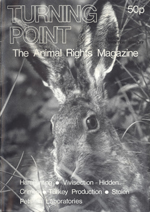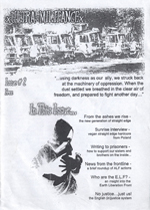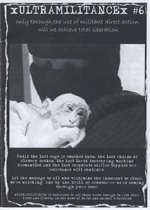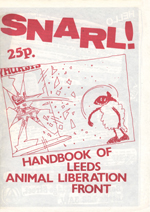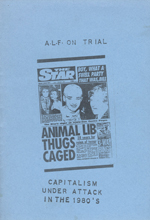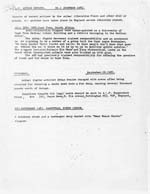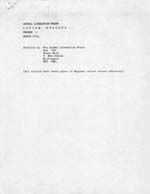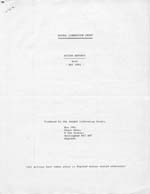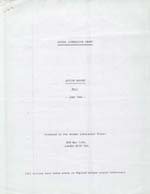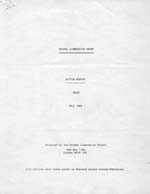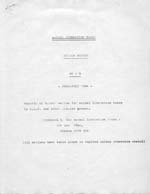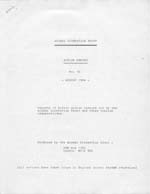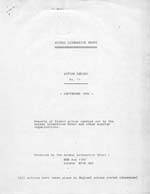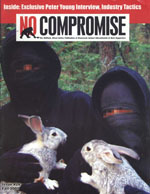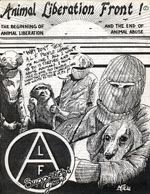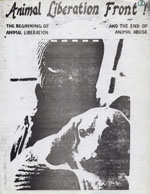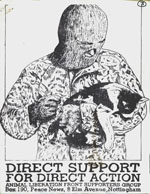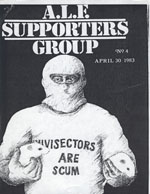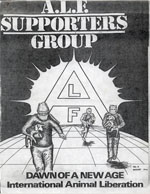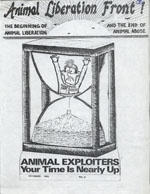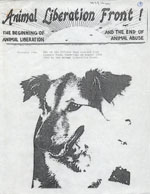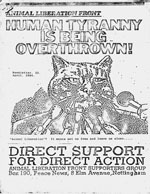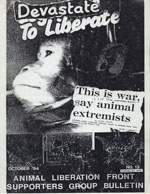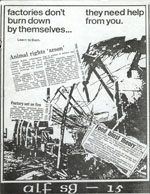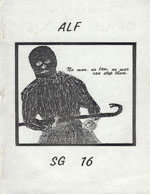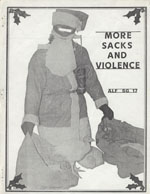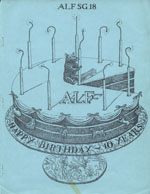The Archives
-
Periodicals
Turning Point #5-6
10.01.14 | PermalinkTURNING POINT – Issues 5-6 (1986-1987, Oxford, UK)
After a brief run as “Black Beast,” Turning Point emerged as England’s foremost animal rights publication in 1986. Featuring first hand accounts of direct action, a decent analysis of systemic animal abuse, and a willingness to be controversial, Turning Point documented all of the major animal liberation events of its era.
Issues #5 and #6 give coverage to mainstream media distortions of AR activism, CALL’s brilliant raids of Park Farm, ALF strikes across England (Including the liberation of three otters!) and so much more. There is even a brief mention of the Farm Freedom Fighters, the first group to raid a factory farm in the United States. Interestingly, their media relations were handled by none other than Farm Sanctuary.
These two volumes are markedly better than the Black Beast issues that preceded them, and all of us at TALON are excited to finally preserve them in our archive.
…
-
One-off publications
The Animal Liberation Primer
01.28.14 | PermalinkThe Animal Liberation Primer (publishing date unknown, location likely the United States)
Containing material mostly culled from other similarly named primers, this is a short how-to guide for small scale property damage, arson*, and liberations. It contains a basic run down of security measures, mental preparation, and history of the Animal Liberation Front. Although it was surely a good resource in its time, its value as a primer has diminished with the advent of new security technologies, legislation, and state-surveillance. Anyone looking to undertake direct action would do well to find a modern source of instruction.
*The United States government fears a public empowered with the means to confront the excesses of their corporate masters, and as such has banned the distribution of literature containing instructions to build destructive devices. You can still purchase a shotgun at Walmart, or a bomb manual on Amazon, but we must censor all instructions here on our site. We apologize to our readers for the impact this has on the completeness of our archive.
…
-
Periodicals
X UltraMilitance X #2, 6
11.19.13 | PermalinkXUltraMilitanceX #2, 6 (2003 – 2005. Bursledon, Hants, England)
While I am not the biggest fan of “vegan straight edge” publications, XUltraMilitanceX manages to fit a few positive aspects into it’s otherwise formulaic, religiously worded format. Between the band interviews, sobriety cheerleading, and calls to “destroy Babylon,” there are some good articles on the history of the movement and a slightly deeper analysis of capitalism, the state, and human supremacy than I would expect from a zine named after an Earth Crisis song. Produced by a former anti-HLS prisoner, this was also one of the few XVX zines written by someone willing to actually act on the lyrics and liner notes that inspired them to begin with.
Issue #2 and #6 are very rare and took us a few years to find, but they complete our collection of this popular zine. The other issues can be found HERE.
…
-
One-off publications
SNARL! Handbook of the Leeds A.L.F.
11.12.13 | PermalinkSNARL! Handbook Of Leeds ALF (1985. Leeds, England)
One of the great things about punk music is also one of the worst things about it: anyone can do it. On the one hand this encourages kids to destroy the adulation of rockstars and to make music (as well as zines, clothes, art, etc) themselves. That accessibility has brought us the voices of people we never would have otherwise heard, which is wonderful. On the other hand, punk doesn’t exist in a vacuum, it came into being in a culture afflicted with bias and brutality, patriarchy, capitalism, and so on. Those elements are ingrained in many of the creators of punk and are, at times, reflected in the works they produce. Those messages are then carried on to those who consume that media.
It isn’t hard to make the leap from an analysis of punk to an analysis of leaderless resistance. Without a hierarchy or organized recruiting mechanism, the A.L.F. has often spread through the same means as punk rock- DIY media, the passion and anger of youth, and at times, sensationalized mainstream media stories. People have heard the call and picked and up the banner, acting on their own initiative to make change. The downside, of course, is that without a training component that goes beyond a few words in a zine about security culture, these newly active saboteurs aren’t always left with the skill set needed to safely or effectively undertake underground actions. They may end up making their own publications which repeat the mistakes of the ones they first read, and these will be passed on to the consumers of that media.
If I were 16 years old and living in Leeds in 1985, I would have loved SNARL. It speaks from a place of youthful (and righteous) rebelliousness, and although the tone can be a little dogmatic, nearly everything else about the “handbook” is just plain cool. I laughed out loud to see license plates, makes and models of undercover police vehicles listed, and was encouraged to see the inclusion of human liberation struggles. That said, the young folks who made this zine were reproducing some of the worst aspects of other publications from the era as far as security and theatrical militancy goes.
SNARL is an interesting product of it’s time, written and distributed by well meaning, hard-fighting folks who no doubt had the best interest of non-humans in their hearts. That said, I hope readers at the time were cautious in following the advice it contained, because much of it was outright dangerous. Looking at the prisoner listings from this period, that doesn’t seem to be the case.
…
-
One-off publications
A.L.F. On Trial – Capitalism Under Attack In The 1980’s
10.29.13 | PermalinkA.L.F. On Trial – Capitalism Under Attack In The 1980’s (1987. England, city of publication unknown.)
On February 5th of 1987 ten British animal liberationists were sentenced to an aggregate of 38 years after a trial prosecutors had designed to “break the back of the ALF.” This case, popularly referred to as the Sheffield Trial, set precedents not only in the UK, but worldwide for the manner in which vegan militants would be tried by the state and media.
Although the Sheffield Trial failed in its goal to end underground direct action for non-humans, it did take a serious toll on the movement. Ronnie Lee was sentenced to 10 years, Roger Yates skipped bail and went on the run, and several others were taken out of the struggle for lengthy periods. The negative media blitz during the trial was among the first to create a popular association between the terms “animal rights” and “terrorist.” Worst of all, Sheffield was the first case in which the charge of “Conspiracy to Commit Criminal Damage” was upheld, essentially allowing radical media producers (In this case Ronnie Lee and the SG Newsletters) to be held responsible for the actions of others the authors had never met or otherwise interacted with- in fact, these other “conspirators” didn’t even have to be known to the authorities. All that needed to be shown was that a publication showed approval for an illegal act and that those acts then continued to occur. (Other courts disagreed with this novel interpretation of the law however, most notably the appeals court in the GANDALF trial.)
Parallels between this case and that of the SHAC 7 and others are clear, but little has been done to learn from the earlier trial. Luckily, an anarchist analysis of the court proceedings from 1987 has survived in the form of this brief, snarky pamphlet.
…
-
Periodicals
The SG newsletter, Volume 2.
07.08.13 | PermalinkSupporters Group Newsletter No.1 (1987 – London, England)
After the original Animal Liberation Front Supporters Group newsletter was repressed out of existence, an attempt was made at a second volume that could survive government harassment. Steps were taken to clear each article with attorneys and the majority of the content was reposted from mainstream news articles. Calls to action were kept out of editorials written by the SG (Although they still appeared in the many first hand accounts and communications sent from those underground) and, in general, the tone was far less militaristic than the final issues of Volume 1.
Sadly, this didn’t save the SG’s volunteers from further political prosecutions.
During this time British security services estimated that up to four hundred direct actions were happening every day in the United Kingdom, with more financial damage being incurred by animal abusers than the British government faced at the hands of the IRA in Northern Ireland. The state was not willing to risk these actions spreading no matter how legal the efforts of those publicising them. So, after a single, wonderful issue, the SG newsletter was once again put out of business. At least they went down fighting! This newsletter features inspiring reports, hilariously snarky editorials, and some of our favorite images from the frontlines of the fight against speciesism. It is truly a must read, and we are proud that, despite the efforts of Scotland Yard and other British law enforcement, The SG is still available here at TALON.
…
-
Campaign newsletters, Periodicals
Support Animal Rights Prisoners newsletters: Year One.
06.17.13 | PermalinkS.A.R.P. Newsletter #1-5 (1991 – Northampton, England)
After a brief existence and quick demise in the 1980’s, the Support Animal Rights Prisoners organization was re-founded by Barry Horne and some friends in 1991. At the time Barry was imprisoned for possession of incendiary devices, but he never let incarceration keep him from participation in the movement. So, using a prison typewriter, he set to work writing the SARP newsletters. There are claims in the first issue that the material in SARP was written by a committee of five volunteers, but information we have received from reliable sources suggest that in actuality Barry wrote every issue of SARP except for the final issue, which was written by ALF Press Officer Robin Webb.
Barry was one of the most dedicated activists our struggle has ever known, but it would be a disservice to him to strip him of his humanity by pretending that he was without error. There are some poorly examined ideas in the pages of SARP that deserve measured critique, most especially that animal rights activists must, in all instances, preserve “unity.” Calls for unity are often used by those guilty of the most destabilizing behaviors as a way to avoid criticism for their own complicity in pushing people apart. During the era that SARP was being published there were concerted efforts by organized racists to join the movement, for car and postal bombings to be supported, and so on. Under such conditions total unity wouldn’t exactly be a good thing, right?
But for every weak idea presented in the pages of SARP, there are also beautiful moments that give voice to our imprisoned comrades, that remember our dead, and that call for nothing less than a revolution to liberate non-humans from the tyranny of the human species. Barry wrote with an intensity and single minded dedication that reminds us of just how precious each second spent fighting is, and how we must stop wasting those ticks of the clock. To Barry, life, and even death, should be utilized battling the scourge of speciesism. These newsletters are Barry’s voice ringing out from decades past, telling us to ACT NOW in solidarity with the animal nations.
…
-
Periodicals
ALF Action Reports
04.15.13 | PermalinkA.L.F. Action Reports #1-11 (1983-1984. London, England)
Because the Animal Liberation Front is without central leadership and exists more as tactic than an organization, most volunteers were never recruited. Instead, they were people who heard about other actions, and when their conscience could take no more of the brutality surrounding them, decided to take actions of their own. By 1983 the government of England was well aware of this. Police PR departments were told to deny that attacks were happening, newspapers were pressured to stop covering direct actions for animals, and raids were carried out against the ALF Supporters Group and other producers of movement media. The government’s logic was that if people were unaware of the Front’s existence, perhaps membership would be lower and fewer attacks would be carried out.
This made it very difficult for interested parties to keep abreast of the multiple actions happening in England every single night. In response the ALF’s press office began to distribute Action Reports, a typewritten diary of every known direct action for non-humans for the month it was produced. In some cases full statements from participants in the underground would be published, other times reports were compiled from mainstream news articles.
The idea of Action Reports soon spread to Australia, the United States, and elsewhere. Eventually these reports evolved into the “Diary of Actions” that became common in radical AR publications such as No Compromise.
…
-
No Compromise, Periodicals
No Compromise #27-28
03.18.13 | PermalinkNo Compromise #27-28 (2005. Santa Cruz / San Francisco, CA)
The volunteer staff of No Compromise may have only published two issues in 2005, but both were valuable sources of news and ideas from across the globe. As always, the reports inside are bitter sweet. Many animals were rescued, many abusers felt some heat, and many people rose up and fought back. Then, there was the backlash, the senate hearings, and the arrests. The movement has never stopped though, and No Comp always served as a reminder that come hell or high water we were all going to forge ahead, sometimes stronger, sometimes weaker.
One unfortunate development in 2005 was the arrest and conviction of Chris “Dirt” McIntosh. Despite receiving movement support, Chris turned to Nazi groups in prison for advice and friendship. Soon, he counted himself among their ranks, and requested to be removed from animal lib prisoner lists. He would have been removed anyway though: there is never room in our struggle for a Nazi!
Luckily, other prisoners continued to show courage, dignity, and resolve from behind bars. Both 2005 issues of NC contain inspiring letters and interviews with jailed comrades. All in all, this is another must read year for the best animal liberation publication to come out of the United States.
…
-
Most Popular, Periodicals, The SG (original 80s volume)
The ALF Supporters Group Newsletter – The complete original set!
03.04.13 | PermalinkThe ALF Supporters Group Newsletter #1-19 (1982-1986. Nottingham / London, England)
When this archive project was founded two years ago, a list was made of the ten publications that we “had to have.” Number one was a complete set of the first volume of “The SG.” This was a tall order, and we knew it. First off, the Animal Liberation Front Supporters Group must be one of the most raided entities in England, and its members were frequently raided themselves! The result was that many copies of the magazine ended up in police custody both before and after distribution, never to be seen again. Second, it was a relatively old newsletter, and since the first issues were mimeographed on cheap paper, finding intact copies was going to be difficult. We persevered though, and now these rare pieces of movement history are preserved digitally and online for everyone to read and learn from.
Started by Dave Nicholls in 1982, the ALF Supporters Group was an effort to do two things: 1.) To raise funds for people arrested for animal related direct actions. 2.) To create a broader base of support for the Animal Liberation Front inside the movement. Both goals were met quickly. Within two weeks of their founding, the Supporters Group hit the number of members they had set as their long term goal. Through direct donations, memberships, fundraising events, and sales of merchandise, the SG was able to contribute towards the sizable legal costs of activists being arrested across England.
The newsletter itself went through varying degrees of quality in writing, layout, and value to the movement. The early days of the Nicholls run may have had a drab interior, but the hand illustrated covers were sometimes gorgeous, and the rhetoric had not yet strayed into the more-militant-than-thou nonsense which came later. Eventually the writing would border on the cultish, but there is scarcely an issue of the magazine that doesn’t have some redeeming value. When read critically and as a whole body of work, this magazine follows the rise and spread of underground action for animals across the globe, illustrates the value of coalition building, and provides solid examples of extremism to be avoided through coverage of groups like the Animal Rights Militia. It also provides many historical details found nowhere else!
“The SG” has gone through several incarnations since British Law enforcement shut this one down in 1986. (While carrying out the investigation for the notorious Sheffield trial that sent Ronnie Lee to prison for 10 years, the police raided the SG and charged it’s editors with incitement. Everything published by the SG afterwords had to be run past a lawyer first, but this didn’t stop further raids, arrests, and convictions of those involved in the newsletter.) It is still being published today, copies can be ordered from www.alfsg.org.uk.
Finally, an excellent analysis and critique of the SG and the rise of England’s “Cult of Militancy” can be found in the book Against All Odds, available here at the Talon Conspiracy.
…

